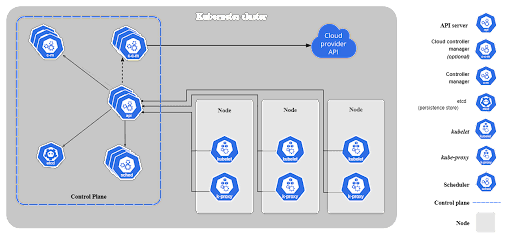control plane and data plane (user plane)
Azure 控制平面和数据平面
https://learn.microsoft.com/zh-cn/azure/azure-resource-manager/management/control-plane-and-data-plane
Azure 操作可以分为两个类别 - 控制平面和数据平面。 本文介绍这两种类型的操作之间的差异。
使用控制平面可管理订阅中的资源。 可以使用数据平面来使用由资源类型的实例公开的功能。
例如:
通过控制平面创建虚拟机。 创建虚拟机后,通过数据平面操作(如远程桌面协议 (RDP))与该虚拟机进行交互。
通过控制平面创建存储帐户。 然后,使用数据平面在存储帐户中读取和写入数据。
通过控制平面创建 Azure Cosmos DB 数据库。 要查询 Azure Cosmos DB 数据库中的数据,可使用数据平面。
Kubernetes Architecture Overview
https://spot.io/resources/kubernetes-architecture/11-core-components-explained/
A Kubernetes cluster has two main components—the control plane and data plane, machines used as compute resources.
The control plane hosts the components used to manage the Kubernetes cluster.
Worker nodes can be virtual machines (VMs) or physical machines. A node hosts pods, which run one or more containers.
Kubernetes nodes can run on regular compute instances or low cost spot instances – learn more in our guide to Kubernetes spot instances
kubernetes cluster architecture diagram
Image Source: Kubernetes
Core Components: Kubernetes Control Plane
The control plane includes components like the API Server, Scheduler, and Controller Manager. The control plane maintains communication with worker nodes. When you deploy applications on Kubernetes, you tell the control plane to start the application’s containers. The control plane then schedules the containers to run on the cluster’s nodes.
Technically speaking, the Kubernetes control plane is a collection of processes that manages the state of a Kubernetes cluster. It receives information about cluster activity and requests, and uses this information to move cluster resources to the desired state. The control plane interacts with individual cluster nodes using the kubelet, an agent deployed on each node.
To have a highly available control plane, you should have at least three control plane nodes with the components replicated across all three nodes.
什么是控制平面?| 控制平面与数据平面
https://www.cloudflare-cn.com/learning/network-layer/what-is-the-control-plane/#:~:text=%E6%8E%A7%E5%88%B6%E5%B9%B3%E9%9D%A2%E6%98%AF%E7%BD%91%E7%BB%9C%E4%B8%AD%E6%8E%A7%E5%88%B6%E6%95%B0%E6%8D%AE%20%E5%8C%85%20%E8%BD%AC%E5%8F%91%E6%96%B9%E5%BC%8F%E7%9A%84%E9%83%A8%E5%88%86%E2%80%94%E2%80%94%E5%8D%B3%E6%95%B0%E6%8D%AE%E5%A6%82%E4%BD%95%E4%BB%8E%E4%B8%80%E4%B8%AA%E5%9C%B0%E6%96%B9%E5%8F%91%E9%80%81%E5%88%B0%E5%8F%A6%E4%B8%80%E4%B8%AA%E5%9C%B0%E6%96%B9%E3%80%82%20%E4%BE%8B%E5%A6%82%EF%BC%8C%E5%88%9B%E5%BB%BA,%E8%B7%AF%E7%94%B1%20%E8%A1%A8%E7%9A%84%E8%BF%87%E7%A8%8B%E8%A2%AB%E8%AE%A4%E4%B8%BA%E6%98%AF%E6%8E%A7%E5%88%B6%E5%B9%B3%E9%9D%A2%E7%9A%84%E4%B8%80%E9%83%A8%E5%88%86%E3%80%82%20%E8%B7%AF%E7%94%B1%E5%99%A8%E4%BD%BF%E7%94%A8%E5%90%84%E7%A7%8D%20%E5%8D%8F%E8%AE%AE%20%E6%9D%A5%E8%AF%86%E5%88%AB%E7%BD%91%E7%BB%9C%E8%B7%AF%E5%BE%84%EF%BC%8C%E5%B9%B6%E5%B0%86%E8%BF%99%E4%BA%9B%E8%B7%AF%E5%BE%84%E5%AD%98%E5%82%A8%E5%9C%A8%E8%B7%AF%E7%94%B1%E8%A1%A8%E4%B8%AD%E3%80%82
什么是网络中的“平面”?
在网络中,平面是特定过程发生位置的抽象概念。该术语是在“存在平面”的意义上使用的。网络中最常引用的两个平面是控制平面和数据平面(也称为转发平面)。
什么是控制平面?
控制平面是网络中控制数据包转发方式的部分——即数据如何从一个地方发送到另一个地方。例如,创建路由表的过程被认为是控制平面的一部分。路由器使用各种协议来识别网络路径,并将这些路径存储在路由表中。
什么是数据平面?什么是转发平面?
与决定如何转发数据包的控制平面相反,数据平面会实际转发数据包。数据平面也称为转发平面。
打个比方,控制平面是在城市道路交叉口工作的交通信号灯。数据平面(或转发平面)则更像是在道路上行驶、在路口停下并遵守交通信号灯的汽车。
Control Plane vs. Data Plane: What Are The Differences?
https://www.splunk.com/en_us/blog/learn/control-plane-vs-data-plane.html
The control plane and the data plane are two key components of a network, each facilitating the flow of network packets, and each with its own set of functions and responsibilities. Understanding the differences between these two planes helps you design and optimize networks for improved performance, scalability, and security.
This article will explore the control and data planes, including their functionalities, fundamental differences and use cases. The article also explains the advantages and drawbacks of decoupling these two components.
What is the control plane?
The control plane is an integral part of a network. It governs everything related to forwarding data packets, or how data is sent from a source to a destination. The control plane is responsible for various functions and processes such as routing table creation, maintenance, forwarding, establishing network policies, managing routing protocols and creating the network topology.
(These functions and processes are all part of the larger concept of managing network configuration.)
The control plane utilizes several protocols such as
OSPF
RIP
BGP
They enable the control plane to exchange routing details and determine the optimal paths for directing network traffic. Usually, the control plane is separated from the data plane, allowing it to become more efficient and scalable. Furthermore, there are distributed and centralized control planes. Those centralized planes are managed by a central controller responsible for making decisions and managing the behavior of network devices.
What is the data plane?
The data plane is the part of networking that forwards network packets between source and destination devices.
As simple analogy to the data and control planes, think of these in a transportation sense:
The control plane works as the traffic controller that controls and routes traffic.
Meanwhile, the data plane acts as the vehicle that transports passengers to the correct destination. (Hence why the data plane is also called the ‘forwarding plane.’)
The data plane performs tasks like receiving and inspecting the packets, forwarding them to the correct destination, queuing network packets during network congestion, and ensuring the safe delivery of packets to the correct destination. Similar to the control plane, the data plane also uses protocols such as Internet Protocol (IP) and Ethernet to carry out its functions. The data plane operates at a lower abstraction level than the control plane — forwarding packets based on the routing configured by the control plane.
What are the differences between the Control Plane and the User Plane in the 5G Core network?
https://www.telecomtrainer.com/what-are-the-differences-between-the-control-plane-and-the-user-plane-in-the-5g-core-network/
In a 5G Core network, the Control Plane and User Plane are two essential components that perform distinct functions. These planes are part of the Service-Based Architecture (SBA) defined in the 3rd Generation Partnership Project (3GPP) specifications for 5G networks. Let's delve into the technical details of each plane:
Control Plane (CP):
Functionality:
The Control Plane is responsible for managing and controlling the establishment, modification, and termination of communication sessions between user devices (UEs) and the network.
It handles signaling, policy enforcement, session management, and mobility management.
Control Plane functions are crucial for maintaining the overall network state and ensuring that user data is routed correctly.User Plane (UP):
Functionality:
The User Plane is responsible for the actual transmission of user data. It is involved in forwarding data packets between the user device (UE) and external networks or services.
The UPF (User Plane Function) plays a central role in the User Plane, handling tasks such as packet routing, forwarding, and encapsulation/decapsulation.



